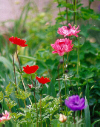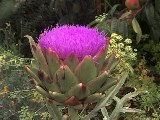HOME PAGE

CAKE & SNACK
Kastella

Dorayaki

Kompeitoh

DRESSING

GARDENING

GREEN TEA
Varieties

Preparation

When
and where
Benefits

PICKLES
Beer-zuke

Hakumai-zuke

Bettara-zuke

NATTO

SUSHI
Rice

Nigiri-zushi

Hako-zushi

Temaki-zushi

Masu-zushi


Gardening Corner
(Links are given for convenience of the readers. We by no means promote
or endorse the companies or organization of the links given on this page.)

If you really miss white aromatic Tokyo onion (best for sukiyaki), plant some in your backyard garden. Seeds of Tokyo onion and its relatives (Tokyo long, Ishikura, Feast) are available at:
STOKES, P.O. Box 548, Buffalo, NY, 14240-0548, TEL 1-800-396-9238, FAX 1-888-834-3334
In the same section of the Stokes' catalog mentioned before, they offer seeds of a pickling onion, Barletta (see the attached photo). Someone said their pickle is very similar to Rakkyo. We will see how close it is, although we cannot answer until late summer.
To plant rakkyo, you have to plant bulbs in autumn because rakkyo does not produce seeds, although they have flowers. The new bulbs are cropped in early summer. Rakkyo grows well in poor. One bulb yields almost ten bulbs next year. The only major difficulties is that source cannot be found easily.
Best article about Rakkyo is:
Garlic and Friends by Penny Woodward, US distribution by Seven Hills Book Distributors, Cincinnati, OH ISBN 1-86447-009-7 (USA)
Artichoke is a delicacy in the Western culinary. Marinated artichokes are delightful as salad. Although artichoke is not popular as food in Japan, it is gaining popularity as flower. Indeed, it is a giant cousin of Japanese thistle and the wild thistle in America (cirsium vulgare).
We are often puzzled, however, why the artichokes sold in the groceries are so hard no matter how long you boil. Canned artichokes are tender. The answer came from a friend in Spain. They pick up artichokes when small and tender. In America, artichokes are left to grow as large as possible. Spanish people don't understand why.

http://www.sfsu.edu/~jtolson/vgarden/1996/html/garticho.htm
Japanese thistle (azami, cirsium japonicum)
http://www.mid.co.jp/biotope/noazami.html
Wild Thistle (cirsium vulgare)
www.the-timeless-dimension.com/p028.htm
If you wish to plant either of them, ask for catalog at:
- Artichoke: Gurneys Seed & Nursery Co., 110 Capital St., Yankton, South Dakota 57079-2099, TEL 1-605-665-1671, FAX 1-605-665-9718
- Japanese thistle: Chiltern Seeds, Bortree Stile,
Ulverton, Cumbria, LA127PB, England.
Email 101344.1340@compuserve.com
Burdock is easy to grow in North America. Indeed, its wild cousin can be easily found in the field. However, for cooking, you have to buy seeds of cultivated burdock, which are often available in Japanese grocery. Saw seeds early in spring. They are strong against frost. By late summer the vegetable is ready to dig.
The toughest part is in digging. Unless you have a good skill of digging long roots, or the soil is very soft, the chance is to lose most part except a small portion near the soil surface. So here is what we do. Cut the bottom of 5 plastic gallon buckets, which were possibly left over from driveway coating in last summer. Place them up side down on the well cultivated soil. Pour mix of compost and good soil into the buckets and harden by tapping from the top. Sow a few seeds on the top. In autumn, you are guaranteed to get all of the roots without fuss.
If one or two plants are left in the garden, they produce seeds next year. Flowers are similar to the thistles.
This is a very interesting plant because, instead of producing seeds, its vine produces small ball called "mukago." http://www.huis.hiroshima-u.ac.jp/~nomura/M/mukago.html Long yum can be grown by sowing mukago or piece of adult yam in a rich soil at a sunny place in spring. The vines must be supported. It takes at least three years before harvest, however.